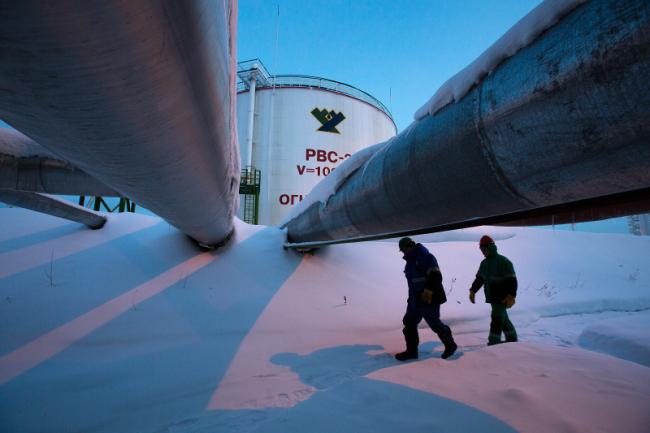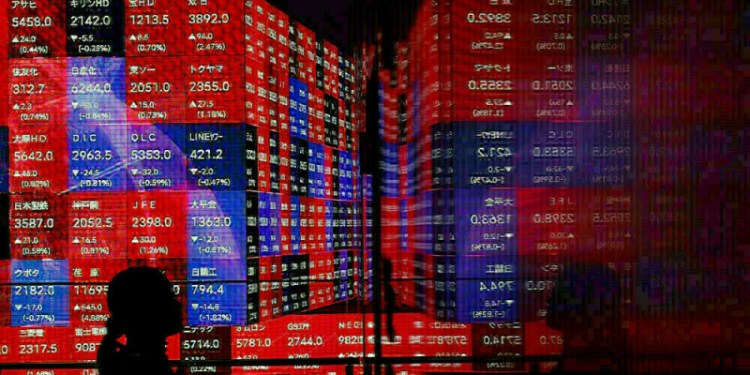 © Bloomberg. Employees pass beneath pipes leading to oil storage tanks at the central processing plant for oil and gas at the Salym Petroleum Development oil fields near the Bazhenov shale formation in Salym, Russia.
© Bloomberg. Employees pass beneath pipes leading to oil storage tanks at the central processing plant for oil and gas at the Salym Petroleum Development oil fields near the Bazhenov shale formation in Salym, Russia.(Bloomberg) — Russia got some breathing room from the U.S. on sanctions last month, but that may not be enough to convince rating companies to return its investment-grade credit score.
Economic growth in the world’s biggest energy exporter last year was “disappointing” and corporate lending is stagnant, according to Karen Vartapetov, an analyst at S&P Global Ratings, which is due to review Russia’s credit ranking on Feb. 23. S&P cut the nation’s rating to junk in 2015 after oil prices plunged and the U.S. and Europe imposed sanctions as punishment for Moscow’s role in the Ukraine crisis.
“It’s about positive triggers,” Vartapetov said in an interview in Moscow. “It’s about an increased pace of growth for the economy and reduced problems in the banking system.”
Russia needs a single upgrade from S&P or Moody’s Investors Service to break free of its junk status. A promotion could trigger inflows of more than $2 billion from funds tracking the main emerging-market Eurobond benchmark indexes. While the risk of tougher restrictions on Russia eased after a milder-than-expected U.S. Treasury report at the end of January, spending pressure in an election year may dent the positive effect of recovering oil prices on the budget, according Vartapetov.
Read More: Russia Back From Junk Could Bring $2 Billion Eurobond Inflow
S&P has kept a positive outlook on Russia for almost a year and investors will be watching its decision on Friday.
Crossroads
The country exited recession last year as the economy grew 1.5 percent, a rate that didn’t meet the government’s expectations, Vartapetov said. At the same time, the Finance Ministry managed to rein in its budget deficit as oil climbed. Growth may quicken to 1.8 percent in 2018, but it’s likely to decelerate from 2019, according to S&P. A slowdown in retail sales growth in January was smaller than forecast, Federal Statistics Service data released Monday showed.
With Russia’s potential for expansion hindered by sanctions and depressed foreign investment, “the government is at a crossroads” and can choose between stimulating growth or protecting the budget, Vartapetov said.
For now, priority has been given to the latter: the government has put a cap on total spending and established a budget rule that squirrels away all revenue from oil above $40 per barrel. Finance Minister Anton Siluanov predicts a surplus of as much as 2 percent if oil prices stay at the current level.
High Uncertainty
There’s still a risk of sanctions being tightened if Congress demands more concrete action, but it’s not S&P’s base-case scenario, Vartapetov said.
Treasury Secretary Steven Mnuchin said that new sanctions will be announced in the “near future,” while earlier specifying that it will impose sanctions on “bad individuals and companies” and not Russia’s sovereign debt.
“Uncertainty is high,” Vartapetov said. “Sanctions are a function not only of Russia’s foreign policy decisions, but of internal political discussions in the U.S. It’s hard to say which is more unpredictable.”
(Updates with January statistics in sixth paragraph.)
Fusion Media or anyone involved with Fusion Media will not accept any liability for loss or damage as a result of reliance on the information including data, quotes, charts and buy/sell signals contained within this website. Please be fully informed regarding the risks and costs associated with trading the financial markets, it is one of the riskiest investment forms possible.
Source: Investing.com





























